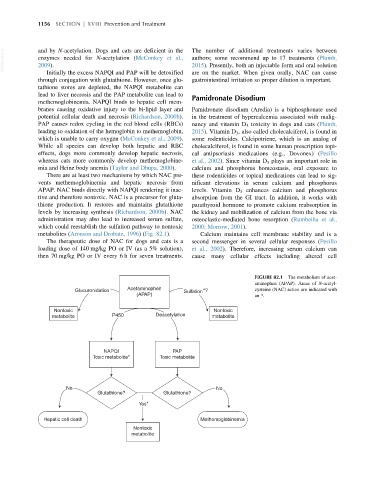Page 1225 - Veterinary Toxicology, Basic and Clinical Principles, 3rd Edition
P. 1225
1156 SECTION | XVIII Prevention and Treatment
VetBooks.ir and by N-acetylation. Dogs and cats are deficient in the The number of additional treatments varies between
authors; some recommend up to 17 treatments (Plumb,
enzymes needed for N-acetylation (McConkey et al.,
2015). Presently, both an injectable form and oral solution
2009).
Initially the excess NAPQI and PAP will be detoxified are on the market. When given orally, NAC can cause
through conjugation with glutathione. However, once glu- gastrointestinal irritation so proper dilution is important.
tathione stores are depleted, the NAPQI metabolite can
lead to liver necrosis and the PAP metabolite can lead to Pamidronate Disodium
methemoglobinemia. NAPQI binds to hepatic cell mem-
branes causing oxidative injury to the bi-lipid layer and Pamidronate disodium (Aredia) is a biphosphonate used
potential cellular death and necrosis (Richardson, 2000b). in the treatment of hypercalcemia associated with malig-
PAP causes redox cycling in the red blood cells (RBCs) nancy and vitamin D 3 toxicity in dogs and cats (Plumb,
leading to oxidation of the hemoglobin to methemoglobin, 2015). Vitamin D 3 , also called cholecalciferol, is found in
which is unable to carry oxygen (McConkey et al., 2009). some rodenticides. Calcipotriene, which is an analog of
While all species can develop both hepatic and RBC cholecalciferol, is found in some human prescription topi-
effects, dogs more commonly develop hepatic necrosis, cal antipsoriasis medications (e.g., Dovonex) (Pesillo
whereas cats more commonly develop methemoglobine- et al., 2002). Since vitamin D 3 plays an important role in
mia and Heinz body anemia (Taylor and Dhupa, 2000). calcium and phosphorus homeostasis, oral exposure to
There are at least two mechanisms by which NAC pre- these rodenticides or topical medications can lead to sig-
vents methemoglobinemia and hepatic necrosis from nificant elevations in serum calcium and phosphorus
APAP. NAC binds directly with NAPQI rendering it inac- levels. Vitamin D 3 enhances calcium and phosphorus
tive and therefore nontoxic. NAC is a precursor for gluta- absorption from the GI tract. In addition, it works with
thione production. It restores and maintains glutathione parathyroid hormone to promote calcium reabsorption in
levels by increasing synthesis (Richardson, 2000b). NAC the kidney and mobilization of calcium from the bone via
administration may also lead to increased serum sulfate, osteoclastic-mediated bone resorption (Rumbeiha et al.,
which could reestablish the sulfation pathway to nontoxic 2000; Morrow, 2001).
metabolites (Aronson and Drobatz, 1996)(Fig. 82.1). Calcium maintains cell membrane stability and is a
The therapeutic dose of NAC for dogs and cats is a second messenger in several cellular responses (Pesillo
loading dose of 140 mg/kg PO or IV (as a 5% solution), et al., 2002). Therefore, increasing serum calcium can
then 70 mg/kg PO or IV every 6 h for seven treatments. cause many cellular effects including altered cell
FIGURE 82.1 The metabolism of acet-
aminophen (APAP). Areas of N-acetyl-
Acetaminophen
Glucuronidation Sulfation *? cysteine (NAC) action are indicated with
(APAP) an *.
Nontoxic Nontoxic
metabolite P450 Deacetylation metabolite
NAPQI PAP
Toxic metabolite* Toxic metabolite
No No
Glutathione? Glutathione?
Yes*
Hepatic cell death Methemoglobinemia
Nontoxic
metabolite

